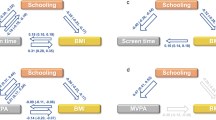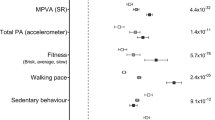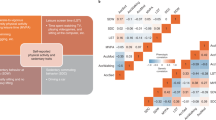Abstract
Background/Objectives:
Multiple studies have revealed an interaction between a variant in the FTO gene and self-reported physical activity on body mass index (BMI). Physical inactivity, such as time spent sitting (TSS) has recently gained attention as an important risk factor for obesity and related diseases. It is possible that FTO interacts with TSS to affect BMI, and/or that FTO’s putative effect on BMI is mediated through TSS.
Subjects/Methods:
We tested these hypotheses in two cohorts of the Framingham Heart Study (FHS) (Offspring: n=3430 and Third Generation: n=3888), and attempted to replicate our results in the Women’s Health Initiative (WHI; n=4756). Specifically, we examined whether an association exists between FTO and self-reported TSS, and whether an interaction exists between FTO and TSS on BMI, while adjusting for several important covariates such as physical activity.
Results:
In FHS, we find a significant positive association between the BMI-increasing FTO allele and TSS. We find a similar trend in WHI. Mediation analyses suggest that the effect of FTO on BMI is mediated through TSS. In FHS, we find a significant interaction of FTO and TSS on BMI, whereby the association of TSS with BMI is greatest among those with more FTO risk alleles. In WHI, we also find a significant interaction, although the direction is opposite to that in FHS. In a meta-analysis of the two data sets, there is no net interaction of FTO with TSS on BMI.
Conclusions:
Our study suggests that FTO exerts its effect on BMI, at least partly, through energy expenditure mechanisms such as TSS. Further research into the intersection of genetics, sedentary behavior and obesity-related outcomes is warranted.
This is a preview of subscription content, access via your institution
Access options
Subscribe to this journal
Receive 12 print issues and online access
$259.00 per year
only $21.58 per issue
Buy this article
- Purchase on Springer Link
- Instant access to full article PDF
Prices may be subject to local taxes which are calculated during checkout
Similar content being viewed by others
References
Stunkard AJ, Sorensen TI, Hanis C, Teasdale TW, Chakraborty R, Schull WJ et al. An adoption study of human obesity. N Engl J Med 1986; 314: 193–198.
Frayling TM, Timpson NJ, Weedon MN, Zeggini E, Freathy RM, Lindgren CM et al. A common variant in the FTO gene is associated with body mass index and predisposes to childhood and adult obesity. Science 2007; 316: 889–894.
Speliotes EK, Willer CJ, Berndt SI, Monda KL, Thorleifsson G, Jackson AU et al. Association analyses of 249,796 individuals reveal 18 new loci associated with body mass index. Nat Genet 2010; 42: 937–948.
Willer CJ, Speliotes EK, Loos RJ, Li S, Lindgren CM, Heid IM et al. Six new loci associated with body mass index highlight a neuronal influence on body weight regulation. Nat Genet 2009; 41: 25–34.
Berthoud H-R, Morrison C .. The brain, appetite, and obesity. Annu Rev Psychol 2008; 59: 55–92.
Heni M, Kullmann S, Veit R, Ketterer C, Frank S, Machicao F et al. Variation in the obesity risk gene FTO determines the postprandial cerebral processing of food stimuli in the prefrontal cortex. Mol Metab 2014; 3: 109–113.
Qi Q, Kilpeläinen TO, Downer MK, Tanaka T, Smith CE, Sluijs I et al. FTO genetic variants, dietary intake, and body mass index: insights from 177,330 individuals. Hum Mol Genet 2014; 23: 6961–6972.
Qi Q, Downer MK, Kilpelainen TO, Taal HR, Barton SJ, Ntalla I . Dietary intake, FTO genetic variants and adiposity: a combined analysis of over 16,000 children and adolescents. Diabetes 2015; 64: 2467–2476.
Kilpeläinen T, Qi L, Brage S, Sharp S, Sonestedt E, Demerath E et al. Physical activity attenuates the influence of FTO variants on obesity risk: a meta-analysis of 218,166 adults and 19,268 children. PLoS Med 2011; 8: e1001116.
Vimaleswaran KS, Li S, Zhao JH, Luan J, Bingham SA, Khaw KT et al. Physical activity attenuates the body mass index-increasing influence of genetic variation in the FTO gene. Am J Clin Nutr 2009; 90: 425–428.
Van der Ploeg HP, Chey T, Korda RJ, Banks E, Bauman A . Sitting time and all-cause mortality risk in 222 497 Australian adults. Arch Intern Med 2012; 172: 494–500.
Yates T, Khunti K, Wilmot EG, Brady E, Webb D, Srinivasan B et al. Self-reported sitting time and markers of inflammation, insulin resistance, and adiposity. Am J Prev Med 2012; 42: 1–7.
Dunstan DW, Thorp AA, Healy GN . Prolonged sitting: is it a distinct coronary heart disease risk factor? Curr Opin Cardiol 2011; 26: 412–419.
Hamilton MT, Hamilton DG, Zderic TW, Syndrome M, Diabetes T . Role of low energy expenditure and sitting in obesity, metabolic syndrome, type 2 diabetes, and cardiovascular disease. Diabetes 2007; 56: 2655–2667.
Hamilton MT, Hamilton DG, Zderic TW . Exercise physiology versus inactivity physiology: an essential concept for understanding lipoprotein lipase regulation. Exerc Sport Sci Rev 2004; 32: 161–166.
Bey L, Hamilton MT . Suppression of skeletal muscle lipoprotein lipase activity during physical inactivity: a molecular reason to maintain daily low-intensity activity. J Physiol 2003; 551: 673–682.
Qi Q, Li Y, Chomistek AK, Kang JH, Curhan GC, Pasquale LR et al. Television watching, leisure time physical activity, and the genetic predisposition in relation to body mass index in women and men. Circulation 2012; 126: 1821–1827.
Graff M, North KE, Richardson AS, Young KM, Mohlke KL, Lange LA et al. Screen time behaviours may interact with obesity genes, independent of physical activity, to influence adolescent BMI in an ethnically diverse cohort. Pediatr Obes 2013; 8: e74–e79.
Dawber TR, Meadors GF, Moore FE Jr . Epidemiological approaches to heart disease: the Framingham Study. Am J Public Health Nations Health 1951; 41: 279–281.
Feinleib M, Kannel WB, Garrison RJ, McNamara PM, Castelli WP . The framingham offspring study. Design and preliminary data. Prev Med 1975; 4: 518–525.
Splansky GL, Corey D, Yang Q, Atwood LD, Cupples LA, Benjamin EJ et al. The third generation cohort of the national heart, lung, and blood Institute’s Framingham Heart Study: design, recruitment, and initial examination. Am J Epidemiol 2007; 165: 1328–1335.
Anderson GL, Cummings SR, Freedman LS, Furberg C, Henderson MM, Johnson SR et al. Design of the Women’s Health Initiative clinical trial and observational study. Control Clin Trials 1998; 19: 61–109.
Franco OH, de Laet C, Peeters A, Jonker J, Mackenbach J, Nusselder W . Effects of physical activity on life expectancy with cardiovascular disease. Arch Intern Med 2005; 165: 2355–2360.
Ainsworth BE, Haskell WL, Leon AS, Jacobs DR, Montoye HJ, Sallis JF et al. Compendium of physical activities: classification of energy costs of human physical activities. Med Sci Sports Exerc 1993; 25: 71–80.
Ware JE, Sherbourne CD . The MOS 36-item short-form health survey (SF-36). I. Conceptual framework and item selection. Med Care 1992; 30: 473–483.
Sims ST, Larson JC, Lamonte MJ, Michael YL, Martin LW, Johnson KC et al. Physical activity and body mass: changes in younger versus older postmenopausal women. Med Sci Sports Exerc 2012; 44: 89–97.
Grant SF, Li M, Bradfield JP, Kim CE, Annaiah K, Santa E et al. Association analysis of the FTO gene with obesity in children of Caucasian and African ancestry reveals a common tagging SNP. PLoS One 2008; 3: e1746.
Do R, Bailey SD, Desbiens K, Belisle A, Montpetit A, Bouchard C et al. Genetic variants of FTO influence adiposity, insulin sensitivity, leptin levels, and resting metabolic rate in the Quebec family study. Diabetes 2008; 57: 1147–1150.
Liu G, Zhu H, Lagou V, Gutin B, Stallmann-Jorgensen IS, Treiber FA et al. FTO variant rs9939609 is associated with body mass index and waist circumference, but not with energy intake or physical activity in European- and African- American youth. BMC Med Genet 2010; 11: 57.
Hennig BJ, Fulford AJ, Sirugo G, Rayco-Solon P, Hattersley AT, Frayling TM et al. FTO gene variation and measures of body mass in an African population. BMC Med Genet 2009; 10: 21.
Adeyemo A, Chen G, Zhou J, Shriner D, Doumatey A, Huang H et al. FTO genetic variation and association with obesity in West Africans and African Americans. Diabetes 2010; 59: 1549–1554.
Gong J, Schumacher F, Lim U, Hindorff LA, Haessler J, Buyske S et al. Fine mapping and identification of BMI loci in African Americans. Am J Hum Genet 2013; 93: 661–671.
Carty CL, Johnson NA, Hutter CM, Reiner AP, Peters U, Tang H et al. Genome-wide association study of body height in African Americans: The Women’s Health Initiative SNP Health Association Resource (SHARe). Hum Mol Genet 2012; 21: 711–720.
Browning BL, Browning SR . A unified approach to genotype imputation and haplotype-phase inference for large data sets of trios and unrelated individuals. Am J Hum Genet 2008; 84: 210–223.
Consortium GP, Abecasis GR, Auton A, Brooks LD, DePristo MA, Durbin RM et al. An integrated map of genetic variation from 1,092 human genomes. Nature 2012; 491: 56–65.
Viechtbauer W . Conducting meta-analyses in R with the metafor package. J Stat Softw 2010; 36: 1–48.
Tingley D, Yamamoto T, Hirose K, Keele L, Imai K . Mediation: R Package for Causal Mediation Analysis. J Stat Softw 2014; 59: 1–38.
R Core Team R: A Language and Environment for Statistical Computing R Foundation for Statistical Computing: Vienna, Austria, 2015. Available from https://www.R-project.org.
Fischer J, Koch L, Emmerling C, Vierkotten J, Peters T, Brüning JC et al. Inactivation of the Fto gene protects from obesity. Nature 2009; 458: 894–898.
Olszewski PK, Fredriksson R, Olszewska AM, Stephansson O, Alsiö J, Radomska KJ et al. Hypothalamic FTO is associated with the regulation of energy intake not feeding reward. BMC Neurosci 2009; 10: 129.
Tung YCL, Rimmington D, O’Rahilly S, Coll AP . Pro-opiomelanocortin modulates the thermogenic and physical activity responses to high-fat feeding and markedly influences dietary fat preference. Endocrinology 2007; 148: 5331–5338.
Gerken T, Girard CA, Tung Y-CL, Webby CJ, Saudek V, Hewitson KS et al. The obesity-associated FTO gene encodes a 2-oxoglutarate-dependent nucleic acid demethylase. Science 2007; 318: 1469–1472.
Speakman JR, Rance KA, Johnstone AM . Polymorphisms of the FTO gene are associated with variation in energy intake, but not energy expenditure. Obesity (Silver Spring) 2008; 16: 1961–1965.
Timpson NJ, Emmett PM, Frayling TM, Rogers I, Hattersley AT, McCarthy MI et al. The fat mass- and obesity-associated locus and dietary intake in children. Am J Clin Nutr 2008; 88: 971–978.
Ahmad T, I-Min LEE, Paré G, Chasman DI, Rose L, Ridker PM et al. Lifestyle interaction with fat mass and obesity-associated (FTO) genotype and risk of obesity in apparently healthy U.S. women. Diabetes Care 2011; 34: 675–680.
Wardle J, Carnell S, Haworth CMA, Farooqi IS, O’Rahilly S, Plomin R . Obesity associated genetic variation in FTO is associated with diminished satiety. J Clin Endocrinol Metab 2008; 93: 3640–3643.
Tanofsky-Kraff M, Han JC, Anandalingam K, Shomaker LB, Columbo KM, Wolkoff LE et al. The FTO gene rs9939609 obesity-risk allele and loss of control over eating. Am J Clin Nutr 2009; 90: 1483–1488.
Thivel D, Metz L, Aucouturier J, Brakoniecki K, Duche P, Morio B . The effects of imposed sedentary behavior and exercise on energy intake in adolescents with obesity. J Dev Behav Pediatr 2013; 34: 616–622.
Granados K, Stephens BR, Malin SK, Zderic TW, Hamilton MT, Braun B . Appetite regulation in response to sitting and energy imbalance. Appl Physiol Nutr Metab 2012; 37: 323–333.
Kilpeläinen TO, Qi L, Brage S, Sharp SJ, Sonestedt E, Demerath E et al. Physical activity attenuates the influence of FTO variants on obesity risk: a meta-analysis of 218,166 adults and 19,268 children. PLoS Med 2011; 8: e1001116.
Acknowledgements
The authors would like to thank the participants and organizers of the FHS, and WHI studies. Data from these studies was obtained from database of Genotypes and Phenotypes through accession numbers: phs000007.v23.p8 and phs000200.v9.p3.c1. YCK was supported by NIH Grant K01DK095032. FHS: The FHS is conducted and supported by the National Heart, Lung and Blood Institute (NHLBI) in collaboration with Boston University (Contract No. N01-HC-25195). This manuscript was not prepared in collaboration with investigators of the FHS and does not necessarily reflect the opinions or views of the FHS, Boston University or NHLBI. Funding for SHARe Affymetrix genotyping was provided by NHLBI Contract N02-HL-64278. SHARe Illumina genotyping was provided under an agreement between Illumina and Boston University. WHI: The WHI program is funded by the National Heart, Lung and Blood Institute, National Institutes of Health, U.S. Department of Health and Human Services through Contracts N01WH22110, 24152, 32100-2, 32105-6, 32108-9, 32111-13, 32115, 32118-32119, 32122, 42107-26, 42129-32 and 44221. This manuscript was not prepared in collaboration with investigators of the WHI, has not been reviewed and/or approved by the WHI, and does not necessarily reflect the opinions of the WHI investigators or the NHLBI. SHARe: Funding for WHI SHARe genotyping was provided by NHLBI Contract N02-HL-64278.
Author contributions
YCK designed the study and wrote the manuscript. AA, AC and YCK performed data management and analysis. YCK, AA, AC, JZ and DR contributed to discussion, helped write the manuscript and reviewed/edited the manuscript.
Author information
Authors and Affiliations
Corresponding author
Ethics declarations
Competing interests
The authors declare no conflict of interest.
Rights and permissions
About this article
Cite this article
Klimentidis, Y., Arora, A., Chougule, A. et al. FTO association and interaction with time spent sitting. Int J Obes 40, 411–416 (2016). https://doi.org/10.1038/ijo.2015.190
Received:
Revised:
Accepted:
Published:
Issue Date:
DOI: https://doi.org/10.1038/ijo.2015.190
This article is cited by
-
Do gene–environment interactions have implications for the precision prevention of type 2 diabetes?
Diabetologia (2022)
-
Genome-wide association studies and Mendelian randomization analyses for leisure sedentary behaviours
Nature Communications (2020)
-
Quantile-dependent heritability of computed tomography, dual-energy x-ray absorptiometry, anthropometric, and bioelectrical measures of adiposity
International Journal of Obesity (2020)
-
Neurobiology of food choices—between energy homeostasis, reward system, and neuroeconomics
e-Neuroforum (2016)



